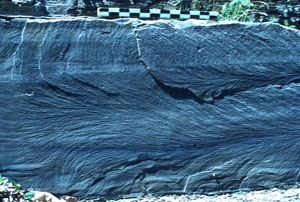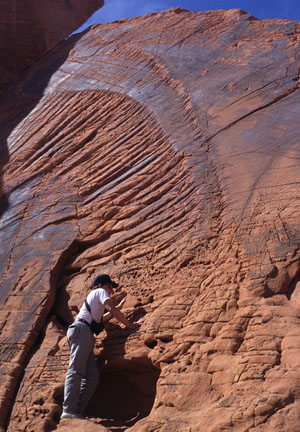| |||||||||
|
|
|||||||||
|
|
|||||||||
| Hackle Marks | |||||||||
|
Hackle marks are surface morphology elements or features commonly observed on joint surfaces. Hackle marks (Figure 1 and Figure 2) are curvilinear boundaries with differential relief between adjacent surfaces, formed when a propagating joint front splits into unaligned partial fronts. Splitting of a crack front in rock may occur at an inhomogeneity, such as a void or inclusion, which locally modifies the stress field such that a crack front warps or splits to remain perpendicular to the maximum tension. Often, joint fronts are subjected to some shear stresses in mode-I and mode-II. Mixed mode I and II stresses result in breakdowns of the joint front.
Hackles either radiate from the origin or fan away from a curvilinear axis. Hackle marks are parallel to the local propagation direction. Hackles normally grow larger as they propagate, but in rare cases like that shown in Figure 3, they may recover to smooth propagation plane. | |||||||||
| Reference: |
|||||||||
| Helgeson, D., Aydin, A., 1991 Pollard, D.D., Aydin, A., 1988 |
|||||||||
|
Readme | About Us | Acknowledgement | How to Cite | Terms of Use | Ⓒ Rock Fracture Knowledgebase |
|||||||||


